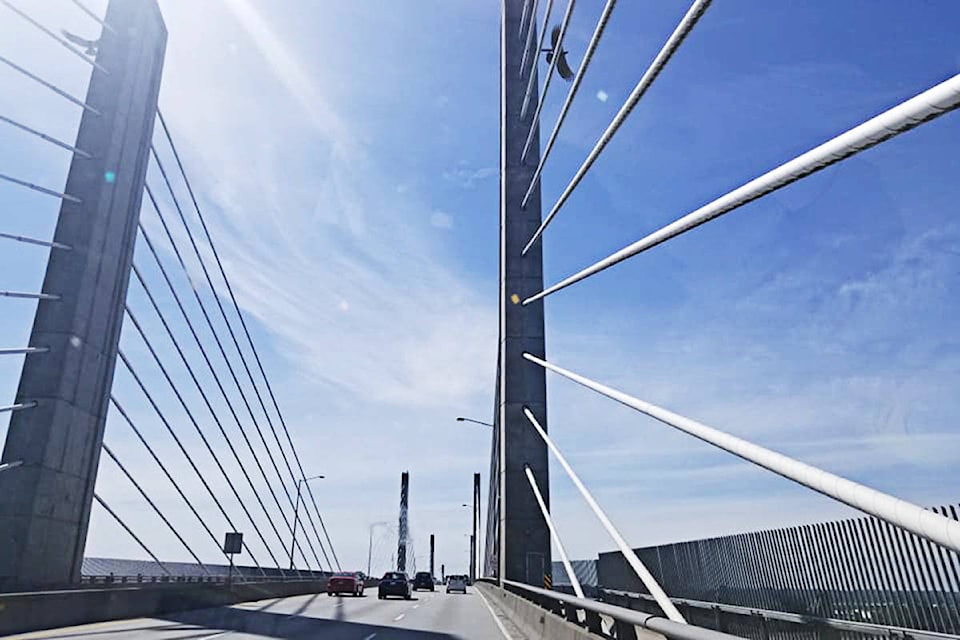A new record was set this May, as more than 60,000 drivers per day crossed the Golden Ears Bridge in a single month.
Numbers have shot up over the last few years, particularly following the removal of tolls on Sept. 1, 2017. July and August numbers were in the range of 41,000 per day, while September saw an immediate leap to 48,800, and the number of travellers crossed 50,000 per day in the spring of 2018.
The new peak number for crossings comes just as the bridge celebrates its 10th anniversary of connecting Langley and the South of the Fraser to Maple Ridge and Pitt Meadows to the north.
The first drivers crossed the Golden Ears Bridge on June 16th, 2009, starting a new era for travellers.
The bridge was a long time coming.
Plans were tossed around as far back as the early 20th Century, but from the 1920s to the 1950s, the main plan was to get a ferry crossing.
Even that took decades, with the first announcement of an imminent ferry connection in 1927. It would take three decades, and multiple scrapped attempts, before the Albion Ferry opened, connecting Glover Road in Langley to Maple Ridge.
“So here is you ferry, which you have wanted for 30 years, so do not ask for a bridge for at least a week,” quipped Evan Jones, then the deputy highways minister, at the ferry’s ribbon cutting ceremony on June 3, 1957.
The ferry simplified travel across the river, but it wasn’t all positive for Fort Langley residents and merchants.
By the 2000s, locals were as likely to complain about the added traffic, which rushed through the village every time a ferry unloaded.
The Kwantlen First Nation’s leadership was not terribly happy with the long lineups that ran past the homes of several band members. They complained about noise and vandalism, particularly by some late-night passengers.
But some merchants in the Fort worried that business would drop off once the ferry closed.
“I am not sure they ever stopped to shop in our village,” said Andy Schildhorn, president of the Fort Langley Community Association. “I remember as the owner of Waldo & Tubbs pet foods giving out hundreds of gift cards etc to drivers in the ferry line up. We never saw one gift card come back to the store.”
By the early 2000s, the provincial government and TransLink were seriously looking into a permanent link across the Fraser. The project was announced in 2003, with 200th Street the preferred corridor. Other suggested locations had ranged from 172nd Street in Surrey, or across Barnston Island at 192nd Street.
Construction began in 2006 on what was planned to be an $808 million project.
Unlike some massive construction projects, the schedule didn’t slip – in fact, the bridge was opened a couple of weeks ahead of a planned July 1 opening. Vehicles had 30 days to test it out toll-free before the automatic license plate readers and transponders on the bridge began collecting tolls.
In 2017, tolls were dropped, along with tolls on the Port Mann Bridge, in accordance with an election promise of the newly-elected NDP government.
That caused another spike in daily traffic, as more drivers opted for the route.
Local mayors said the project has caused a big difference for communities on both sides of the river.
“Its construction helped companies such as Overwaitea and Best Buy make the decision to locate retail chain warehouses and grow in northwest Langley, creating jobs and enhancing our commercial climate,” said Langley Township Mayor Jack Froese. “And it is certainly appreciated by those who commute to work, offering direct access to other transportation networks such as the West Coast Express and the Carvolth Exchange.”
He also noted that the ending of ferry traffic meant an opportunity to return Glover Road north of the Jacob Haldi Bridge to the Kwantlen First Nation.
Commerce and travel has been expanded, said the mayor of Maple Ridge.
“You can see today, though, that the removal of the tolls has created quite an indicator of how much cross traffic there is in between the communities,” said Mayor Mike Morden of Maple Ridge.
It’s also given people from the Maple Ridge side access to a border crossing within about 20 minutes, Morden said – something that wasn’t close to possible before the bridge.
Langley City has seen more access for people visiting shops and restaurants, and coming to regional and local attractions, said the City’s Mayor Val van den Broek.
“Langley City noticed a significant difference when the provincial government eliminated tolls on the bridges,” van den Broek said.
“For us, having that bridge has just been a godsend,” said Bill Dingwall, mayor of Pitt Meadows.
Local tourism and shopping has benefited, he said.
“People on the south side of the Fraser can come and enjoy Pitt Meadows,” Dingwall said.
With more than 60,000 vehicles crossing the bridge on an average day in the spring, that means that about 1.8 million vehicles cross the Golden Ears Bridge every month.
